Transferts monétaires et mobilité humaine
Les transferts monétaires sont souvent utilisés lors de crises afin de répondre aux besoins des personnes migrantes. Dans cette page, vous trouverez des ressources sur les transferts monétaires et la migration.

La Croix-Rouge se prépare à fournir une aide humanitaire aux migrant·es de la caravane sur le point de quitter le Honduras pour le Guatemala.
©Johannes Chinchilla / FICR.
Conflits, crises économiques et catastrophes sont autant de raisons ayant contraint des personnes à fuir et à traverser des frontières dans des conditions éprouvantes et risquées, en quête de sécurité et de moyens de subsistance. En 2020, le nombre de personnes déplacées de force s’est envolé au niveau sans précédent de plus de 80 millions de personnes, soit près du double du nombre enregistré il y a une dizaine d’année. Cette tendance s’aggrave et les effets du changement climatique menacent de déplacer jusqu’à 200 millions de personnes d’ici 2050.
L’assistance monétaire est de plus en plus utilisée afin de répondre aux besoins des personnes en situation de déplacement. On y a eu recours à grande échelle dans différents contextes de migration, en Europe en 2015 jusqu’au Venezuela pour « los caminantes ». Elle a également été utilisée dans d’autres crises migratoires, notamment en Amérique centrale, au Sahel, en Méditerranée et dans la Corne de l’Afrique. L’assistance monétaire est à l’heure actuelle l’une des principales formes d’aide apportée aux populations déplacées en Ukraine et dans les pays voisins.
Il existe une myriade de perspectives et de définitions concernant le mot « migrant·e » et la façon dont les humanitaires doivent agir. C’est pourquoi nous ne choisissons pas une définition unique pour le moment, étant donné que les discussions sur l’assistance monétaire et la migration en sont encore à leurs prémices et que le langage évolue encore.
Documenter et partager les données probantes donnera lieu à des interventions plus efficaces. Cette page contient une sélection de ressources utiles concernant la migration et le recours à l’assistance monétaire. Elle sera mise à jour au fil des discussions ayant lieu dans les espaces humanitaires des transferts monétaires.
Priorités actuelles
Afin de contribuer aux progrès relatifs à cet enjeu, nous nous engageons à :
- soutenir la création de données probantes aux niveaux régional et mondial ;
- contribuer aux solutions pratiques visant à mettre en œuvre les transferts monétaires auprès des personnes migrantes ;
- organiser des discussions sur les enjeux majeurs basées sur des données probantes.
Contenu récent
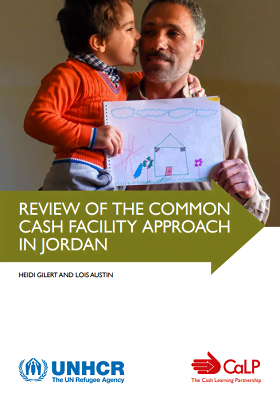
Review of the Common Cash Facility approach in Jordan
Report
The United Nations High Commissioner for Refugees (UNHCR) in Jordan has pioneered a collaborative, multi-stakeholder approach to the delivery of cash, known as the Common Cash Facility (CCF). The aim of the CCF is to provide humanitarian actors with direct and equal access to a common financial service...

Checking Back – Using Cash and Vouchers in Somalia: Recommendations from the 2011-12 Somalia Drought Response
Report
This paper brings together recommendations from some of the key reports and evaluations from the 2011 Somalia drought response. The process of preparing this paper involved reviewing 17 reports and identifying five that had recommendations which could be useful for all agencies involved the current...

Humanitarian Cash Transfers in the Democratic Republic of the Congo: Evidence from UNICEF’s ARCC II Programme
Report
From March 2013 to September 2015, UNICEF and three partner organizations (Concern Worldwide, Mercy Corps, and Solidarités International), collaborated to deliver what was at the time the single-largest unconditional cash transfer programme for humanitarian response in the Democratic Republic of the...

Community Based Targeting Report
Report
The current study aimed to gain a comprehensive understanding of SEV from the community’s perspective and to assess the targeting practices implemented by cash actors in Lebanon. It demonstrated that, according to the community, HH size had an impact on vulnerability, but that that depended on its...

Fitting aid to context: community experiences of aid delivery in northern Syria
Report
The ongoing conflict in Syria has left 13.5 million Syrians in need of humanitarian assistance. Several local and international organisations provide aid to northern Syria, but their chosen modalities fail to effectively meet community members’ needs. While aiming to respond to immediate short-term...
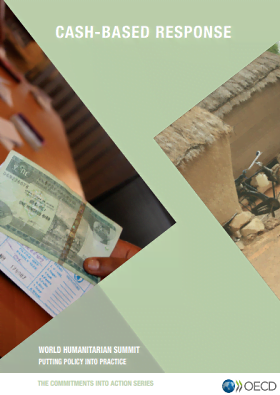
Cash-Based Response- OECD Commitments into Action Series
Report
The use of cash in humanitarian response is not new. What is new, notably after the World Humanitarian Summit and the Grand Bargain, is the policy momentum for using cash as a primary option in responding to humanitarian needs. There is a growing body of evidence demonstrating its multiple benefits as...
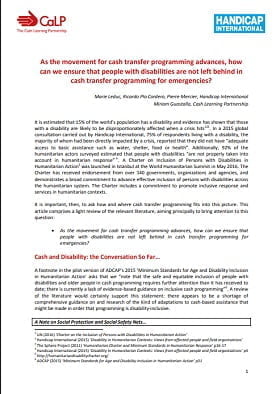
As the movement for cash transfer programming advances, how can we ensure that people with disabilities are not left behind in cash transfer programming for emergencies?
Report
It is estimated that 15% of the world’s population has a disability and evidence has shown that those with a disability are likely to be disproportionately affected when a crisis hits. In a 2015 global consultation carried out by Handicap International, 75% of respondents living with a disability, the...
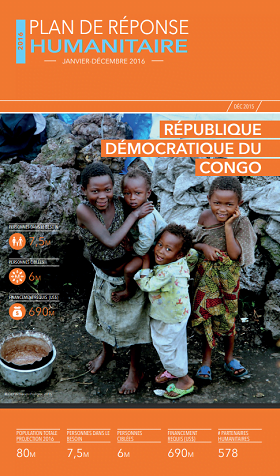
2016 Plan De Reponse Humanitaire
Rapport
L’analyse de la crise, menée par la communauté humanitaire à travers tout le pays, a permis de dégager ses principaux moteurs ainsi que ses manifestations les plus importantes :
• L’Ouest du pays n’est pas épargné.
Bien que l’Est de la RDC demeure la partie du pays la plus frappée par la...
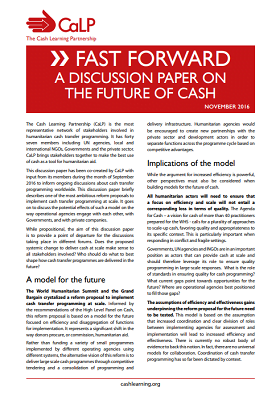
Fast Forward. A discussion paper on the future of cash
Report
This discussion paper has been co-created by the CALP Network with input from its members during the month of September 2016 to inform ongoing discussions about cash transfer programming worldwide. This discussion paper briefly describes one of the most ambitious reform proposals to implement cash...

Field manual for humanitarian e-voucher programs in Turkey
Guidelines and Tools
Welthungerhilfe has been active using e-vouchers in response to the Syrian refugee crisis since 2014, and has provided more than 100,000 individuals with unconditional cash transfers funded by the Federal German Foreign Office, ECHO, the European Commission’s Humanitarian Aid Office, and UNICEF....

10 things you should know about cash transfers
Blog Post
Watch the video here. Nearly 90 million people around the world are in need of humanitarian aid. One great way to help them is by giving people cash instead of goods like food and clothes. It’s simple, and helps more people, more effectively. Interested? Here are 10 things you should know about cash...

10 things you should know about cash transfers
Video
Watch the video here. Nearly 90 million people around the world are in need of humanitarian aid. One great way to help them is by giving people cash instead of goods like food and clothes. It’s simple, and helps more people, more effectively. Interested? Here are 10 things you should know about cash...

Food or Cash or Vouchers? New report on U.S. food assistance monitoring and evaluation suggests “All of the above”
Blog Post
In this special blog Jenny Coneff, the CALP Network's North America Focal Point, reflects on the main findings of the GAO report.
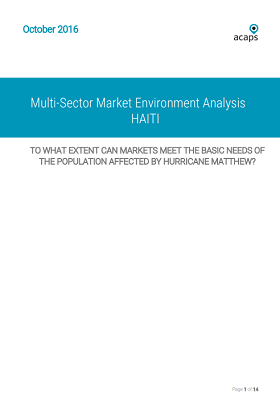
Multi-Sector Market Environment Analysis – Haiti. To what extent can markets meet the basic needs of the population affected by Hurricane Matthew
Report
Relief interventions in Haiti, including those to the 2010 earthquake, have been criticised for their (potential) harmful effect on the national market systems (ALNAP 2011 Humanitarian Coalition 2012). This multi-sector report intends to strengthen the understanding of the market environment in the...
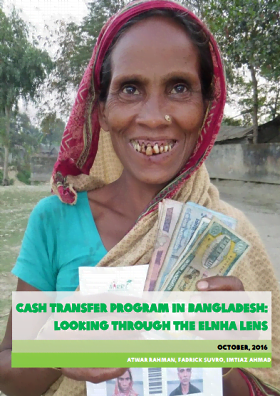
Cash Transfer Program In Bangladesh: Looking Through The ELNHA Lens
Report
Oxfam is implementing a multi-country humanitarian capacity building project titled as ‘’Empowering Local and National Humanitarian Actors (ELNHA)’’ in Bangladesh. This project is designed to use a variety of approaches that will enable local and national humanitarian actors (LNHAs) to take the...
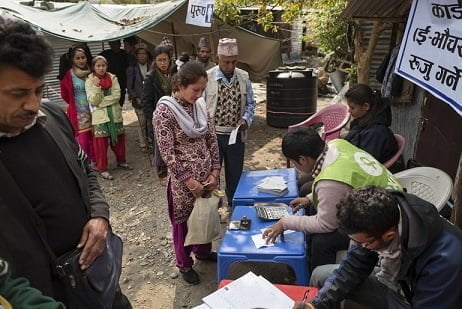
Cash is the answer to change the global aid system
Blog Post
A variety of studies show that recipients of cash not only use the assistance to meet immediate needs (food, shelter, health, schooling) but they also use it to invest in businesses. Cash is not only a dignified way of helping people in need get back on their feet, it incentivises and supports...

Gender Analysis for MVAC Emergency Cash Transfer Programme
Report
Cash Transfers (CTs) provided an effective means of supporting men and women to meet their basic needs in an emergency. CTs assisted men and women to meet their practical needs, giving men a sense of purpose as a provider, and allowing women to fulfil their traditional roles as wife and mother. CTs led...
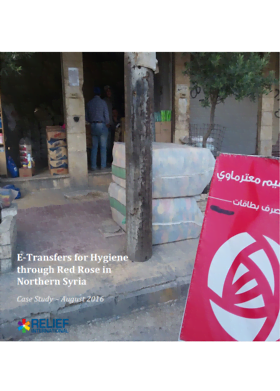
E-Transfers for Hygiene through Red Rose in Northern Syria
Report
Cash is receiving a lot of attention globally and is currently being scaled-up at the highest level. On the 9th February 2016, the UN Secretary-General Ban Ki-moon launched his report for the World Humanitarian Summit, calling for cash-based programming to be the ‘default method of support for affected...
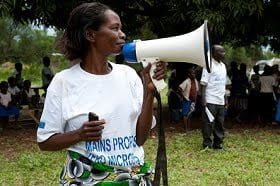
Documenting learning from cash transfer programming in the Ebola context
Blog Post
The CALP Network in West Africa is launching a new Cash and Ebola project that aims to optimize the use of CTP in future crises by documenting, analyzing and providing recommendations from the use of CTP in the Ebola Crisis.
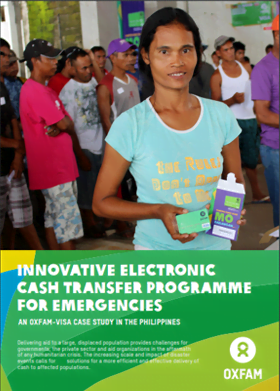
Innovative Electronic Cash Transfer Programme for Emergencies. An Oxfam Visa case study in Philippines
Report
On November 8, 2013, super Typhoon Haiyan (local name Yolanda) struck the Philippines, killing more than 6,000 people, and displacing an estimated 4.4 million individuals. Through its cash transfer programme, Oxfam conducted cash for work activities, and provided cash asset recovery to more than...